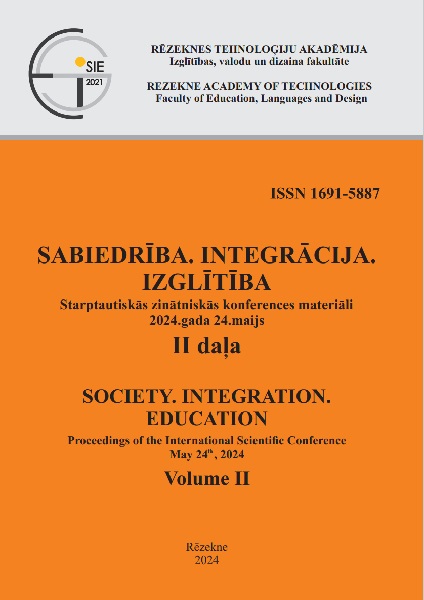EXPLORING STAFFING PATTERNS AND MULTILINGUAL CLASSROOMS IN TEACHING JAPANESE AS A FOREIGN LANGUAGE
DOI:
https://doi.org/10.17770/sie2024vol2.7891Keywords:
Japanese as a foreign language, learning environment, multilingual classrooms, non-native Japanese teachers, teacher staffing patternsAbstract
Multilingual classrooms are becoming more common worldwide due to increasing mobility. Teaching foreign languages using the mother tongue in multilingual classrooms has become problematic; some of the significant concerns in Japanese language acquisition – such as the high contextuality of the language, vocabulary and kanji learning – make the direct teaching method confusing for many students, especially at the beginner and elementary levels. This article provides the preliminary results of a study carried out as a component of a more extensive empirical research project on instructional languages in classrooms teaching Japanese as a foreign language. It aims to gather, analyse and synthesise data from a survey conducted at a supranational level. The results of the first two sections of a questionnaire containing closed and open-ended questions were used for a quantitative analysis of the profile of Japanese language instructors with a focus on finding possible connections. The wide geographic distribution of the respondents (274 teachers from fifty-seven countries and regions) made it possible to collect data from a more representative sample and draw meaningful conclusions about the spread of multilingual classrooms that would be impossible in smaller-scale research. The study’s primary results show the proportion of multilingual classrooms among countries in different regions and across different educational stages, the distribution of Japanese language instructors in various educational stages depending on the highest level of formal education attained, and the proportion of part-time instructors working in different academic institutions.
References
Alba de la Fuente, A., & Lacroix, H. (2015). Multilingual learners and foreign language acquisition: Insights into the effects of prior linguistic knowledge. Language Learning in Higher Education, 5(1), 45–57. DOI: https://doi.org/10.1515/cercles-2015-0003
Beaton, F., & Gilbert, A. (2013). Developing Effective Part-time Teachers in Higher Education. Routledge.
Bruen, J., & Kelly, N. (2017). Mother-tongue diversity in the foreign language classroom: Perspectives on the experiences of non-native speakers of English studying foreign languages in an English-medium university. Language Learning in Higher Education, 7(2), 353–369. DOI: https://doi.org/10.1515/cercles-2017-0014
Christison, M., Krulatz, A., & Sevinç, Y. (2021). Supporting teachers of multilingual young learners: Multilingual approach to diversity in education (MADE). In: J. Rokita-Jaśkow, A. Wolanin (Ed.) Facing Diversity in Child Foreign Language Education. Second Language Learning and Teaching (271–289). Springer, Cham. DOI: https://doi.org/10.1007/978-3-030-66022-2_15
Dowdle, B. C. (2020). The generalist’s dilemma: How accidental language teachers are at the center of Japanese pedagogy. Japanese Language and Literature, 54(2), 383–389. DOI: https://doi.org/10.5195/jll.2020.136
Education GPS. (2023). Review education policies. OECD. Retrieved from: https://gpseducation.oecd.org/revieweducationpolicies/#!node=41710&filter=all
European Commission, Directorate-General for Education, Youth, Sport and Culture. (2015). Language Teaching and Learning in Multilingual Classrooms. Publications Office. Retrieved from: https://data.europa.eu/doi/10.2766/766802
Frutas, M. L. (2023). Breaking the mold: How pre-service teachers’ learning styles are revolutionizing teaching and learning. Journal for Educators, Teachers and Trainers, 14(3). 667-678. Retrieved from: https://core.ac.uk/outputs/574722126
Galan, C. (2018). Students, teachers, language, educational methods and new media: Where should we anchor Japanese language teaching? Some reflections from the field. Japanese Language Education in Europe, 22, 13–28. Retrieved from: https://eaje.eu/pdfdownload/pdfdownload.php?index=28-43&filename=kicho-galan.pdf&p=lisbon
Kim, Y. H. (2003). Staffing in school education. In: J.P. Keeves & R. Watanabe (Ed.) International Handbook of Educational Research in the Asia-Pacific Region. Springer International Handbooks of Education (959–971). Dordrecht: Kluwer Academic Publishers. DOI: https://doi.org/10.1007/978-94-017-3368-7_66
Linn, A., & Radjabzade, S. (2020). English-Medium Instruction in Higher Education in the Countries of the South Caucasus. London: British Council.
Mori, J., & Hasegawa, A. (2020a). Diversity, inclusion and professionalism in Japanese language education: introduction to the special section. Japanese Language and Literature, 54(2), 253–266. DOI: https://doi.org/10.5195/jll.2020.125
Mori, J., Hasegawa, A., Park, J., & Suzuki, K. (2020b). On goals of language education and teacher diversity: beliefs and experiences of Japanese-language educators in North America. Japanese Language and Literature, 54(2), 267–304. DOI: https://doi.org/10.5195/jll.2020.131
Moritoki, N. (2018). Learner motivation and teaching aims of Japanese language instruction in Slovenia, Acta Linguistica Asiatica, 8(1), 39–50. DOI: https://doi.org/10.4312/ala.8.1.39-50
Ohta, A. S. (2020). Increasing diversity of Japanese language teachers: approaches to teaching-related professional development for college students in North America. Japanese Language and Literature, 54(2), 399–414. DOI: https://doi.org/10.5195/jll.2020.139
Schleicher, A. (2011). Building a High-Quality Teaching Profession: Lessons from around the World. Paris: OECD Publishing. Retrieved from: http://dx.doi.org/10.1787/9789264113046-en
The Japan Foundation. (2021). Survey 2021: Search Engine for Institutions Offering Japanese-Language Education. Retrieved from: https://www.japanese.jpf.go.jp/do/index
The Japan Foundation. (2023). Survey Report on Japanese-Language Education Abroad 2021. Tokyo: The Japan Foundation. Retrieved from: https://www.jpf.go.jp/e/project/japanese/survey/result/dl/survey2021/All_contents_r2.pdf
UNESCO, & UNICEF. (2020). Approaches to Language in Education for Migrants and Refugees in The Asia-Pacific Region. Paris: United Nations Educational, Scientific and Cultural Organization. Retrieved from: https://unesdoc.unesco.org/ark:/48223/pf0000373660
Winch, J. (2016). A case study of Japanese language teaching in a multicultural learning environment. IAFOR Journal of Language Learning, 2(1). DOI: https://doi.org/10.22492/ijll.2.1.01






